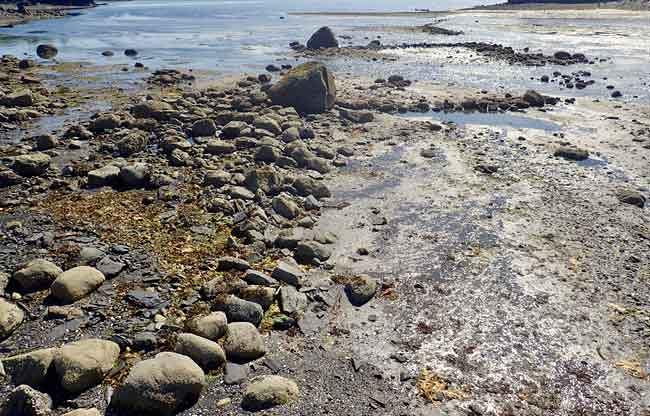 |
Canku Ota
|
 |
|
(Many Paths)
|
||
|
An Online Newsletter
Celebrating Native America
|
||
|
August 2017 - Volume
15 Number 8
|
||
|
|
||
|
Prehistoric Fish
Trap And Petroglyphs Found On Kodiak Island
|
||
|
by Patrick Saltonstall
- Alutiiq Museum
|
||
Alutiiq Museum archaeologists have located the remains of a stone fish trap and an associated set of petroglyphs on northern Kodiak Island. The features are believed to be prehistoric and reflect Alutiiq salmon fishing traditions. While petroglyphs are a well-known feature of Kodiak’s cultural landscape, the fish trap is a rare find. It is the first intertidal fishing structure identified in the Kodiak region. The trap lies in the lower intertidal zone, a muddy area below the mouth of a productive salmon stream. At high tide, salmon headed up the stream could swim over the stone-walled feature, but as the tide dropped, fish were stranded in one of two corrals. The walls of the corrals are incomplete today. However, the alignment of the remaining stones illustrates the shape and size of the ancient structure. One of the corrals is a semi-rectangular arrangement of stones, the other is u-shaped, and there is a gap between the two. Together the stone features stretch an estimated 150 meters. “This method of fishing is well known along the North Pacific coast,” said Patrick Saltonstall, the archaeologist who identified the trap. “Researchers have found stone traps and wooden weirs from southeast Alaska to the coast of Oregon. This recent find illustrates that people used this technology as far north as Kodiak.”
On the shore adjacent to the trap, Saltonstall also recorded a set of previously undocumented petroglyphs. A slate slab, about a meter across, features a series of pecked, circular holes and faintly incised lines. These petroglyphs are different than the human faces and animals carved on boulders at Cape Alitak or along the shore of Afognak Bay, but they closely resemble petroglyphs found beside other salmon streams in the archipelago. These carvings may be a territorial marker, but their meaning is unknown. The trap and the petroglyphs are part of a set of sites that include four, ancient, sod house villages. Saltonstall estimates that small communities date within the past 2,000 years and reflect efforts to harvest large quantities of fish to feed a growing Native population. “The fish trap took a lot of work to build and maintain. I imagine that it was reused year after year and that it was owned by a community or an extended family. It’s not surprising that Alutiiq families used this technology. Many lines of archaeological evidence indicate that Alutiiq ancestors developed tools to efficiently harvest large quantities of fish. A fish trap is another great example.” The museum’s archaeological research is part of a multi-year project with the Afognak Native Corporation to document ancestral sites on the corporation’s lands. Grant funds from the National Park Service Tribal Preservation Program are allowing museum researchers to study shoreline areas. The petroglyphs fall on Afognak Native Corporation lands. The fish trap remains are below the mean high tide line and thus fall on adjacent State of Alaska lands. The Alutiiq Museum is a non-profit organization dedicated to preserving and sharing the history and culture of the Alutiiq, an Alaska Native tribal people. Representatives of Kodiak Alutiiq organizations govern the museum with funding from charitable contributions, memberships, grants, contracts, and sales.
Alutiiq
Museum |
||||
|
|
|
|
||
|
|
||
| Canku Ota is a free Newsletter celebrating Native America, its traditions and accomplishments . We do not provide subscriber or visitor names to anyone. Some articles presented in Canku Ota may contain copyright material. We have received appropriate permissions for republishing any articles. Material appearing here is distributed without profit or monetary gain to those who have expressed an interest. This is in accordance with Title 17 U.S.C. Section 107. | ||
|
Canku Ota is a copyright ©
2000 - 2017 of Vicki Williams Barry and Paul Barry.
|
||
 |
 |
|
|
The "Canku
Ota - A Newsletter Celebrating Native America" web site and
its design is the
|
||
|
Copyright ©
1999 - 2017 of Paul C. Barry.
|
||
|
All Rights Reserved.
|
||

